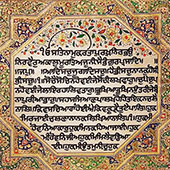Gurmukhi Manuscript - Style Writing
Introduction to the Gurmukhi Script
Gurmukhī: Philosophy behind the Name
ਗੁਰਮੁਖੀ: ਨਾਮ ਦਾ ਦਰਸ਼ਨ
Letters of a script are the seeds of a certain culture. Gurmukhī akhars/letters signify the Punjabi culture and heritage. Gurmukhī is a compound word, made of two words: ਗੁਰੂ (Guru) and ਮੁਖੀ (Mukhi) – meaning Guru’s sayings/ utterences. Historically, the script is named so, meaning that the letters and words as part of sacred utterances from the mukh (mouth) of the Sikh Gurus while reading the hymns from the Guru Granth Saheb (ਗੁਰੂ ਗ੍ਰੰਥ ਸਾਹਿਬ). When the holy utterances are sung as hymns by a Sikh Guru, this musical form of reading them in Gurmukhī script is devotionally called Gurbani (Gur ki Bani meaning ‘from the mouth of the Guru’) with the purpose of teaching of the Guru Granth Sahib Ji.
Around 300 years ago, the tenth sikh guru: Guru Gobind Singh ji, announced that since he would be the last of the living human Sikh Gurus, the sacred text of Adi Granth be the final, everlasting guru, to be called Guru Granth Sahib: GGS.
The standard version of the Mūl Mantar as part of beginning chapter from the Guru Granth Sahib [1]
After the first Amrit Ceremony, the tenth sikh guru: Guru Gobind Singh ji gave the Khalsa a code by which to live their lives. A key part of that code includes the recitation of and meditation on certain Banis. Banis are Sacred Teachings in form of Songs; and written in the Gurmukhi script – given by the Divine to the Sikh Masters.
Guru Ram Das said:
ਬਾਨੀ ਗੁਰੂ, ਗੁਰੂ ਹੈ ਬਾਨੀ
ਵਿਚ ਬਾਨੀ ਅੰਮ੍ਰਿਤ ਸਾਰੇ |
ਗੁਰ ਬਾਨੀ ਕੇਹੈ, ਸੇਵਕ ਜਨ ਮਾਨੈ
ਪ੍ਰਤੱਖ ਗੁਰੂ ਨਿਸਤਾਰੈ ||
“Bani is the Guru and Guru is the Bani.
In the Bani are contained all the nectars.
If the servant obeys whatever the Guru says,
The Guru, in person, saves him.”
-Siri Guru Granth Sahib, Nat, 4th Mehl, Guru Ram Das, p. 982
- Introduction
- Holy Gurmukhi Script - Birth and Developments
- The Gurmukhi Akhars / Alphabets
- The Patrons and Manuscript-Style Written Granths
- The Traditional Lipi and Writing Practice with Paintī (35) Akhars
- Culture-Form Associations
- Categorization in the Ik Onkar Series
- The Personality Mapping
- Digitizing Few Selective Akhars
- Conclusions
- References
- Downloads
- Contact Details
- Credits



